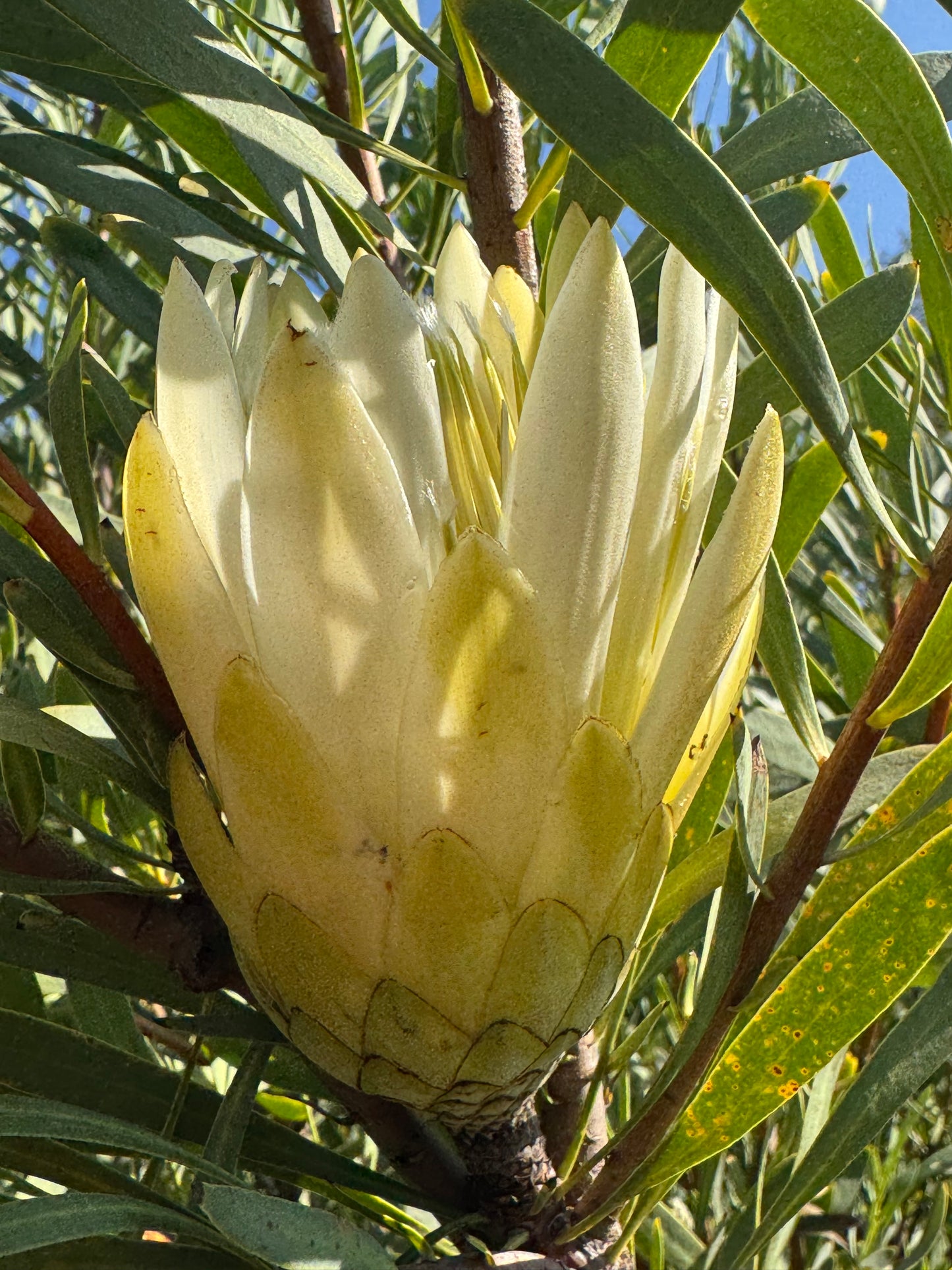Bonte Farm
Protea repens: A Versatile South African Gem, A Spiky Sensation
Protea repens: A Versatile South African Gem, A Spiky Sensation
Couldn't load pickup availability
🍯 Protea repens: The Classic, Nectar-Rich Sugarbush
The Protea repens, commonly known as the Sugarbush, is one of the most iconic, widely grown, and highly adaptable Protea species. Historically revered for its sweet nectar, which was boiled down to make syrup, this hardy evergreen shrub produces abundant, neat, cone-shaped blooms in classic shades of rosy-red or sometimes white/pink, always tipped with a fluffy white/silver beard. P. repens is a robust and resilient specimen plant for Mediterranean, coastal, and xeriscape gardens. Its hardiness, excellent drought tolerance, and dense, upright form make it a reliable, low-maintenance choice, yielding superb, straight-stemmed cut flowers and attracting nectar-feeding birds with its sweet yield.
Botanical Characteristics
|
Characteristic |
Detail |
|
Scientific Name |
Protea repens (The Species) |
|
Common Names |
Sugarbush, Sugar-Protea, Honey Protea. |
|
Growth Habit |
A sturdy, upright evergreen shrub forming a dense, rounded, and naturally bushy canopy. |
|
Foliage |
Features slender, slightly curved, leathery leaves that are deep green and densely packed along the stems. |
|
Flowers |
Medium, distinctive cone-shaped flower heads (bracts), typically 4–5 inches long. Color is highly variable, ranging from a vibrant rosy-red or crimson to paler pinks and whites, often with a white, hairy tip. |
|
Flowering Season |
Known for its very long and persistent bloom period, typically flowering heavily from late fall through spring. |
|
Nectar Production |
Famous for producing copious amounts of sweet nectar (sugar water) at the base of the flower head. |
Export to Sheets
Mature Size
P. repens is a substantial shrub, providing excellent screening and structural integrity.
- Height: Typically reaches 6–10 feet (1.8–3.0 meters) tall.
- Spread: Achieves a dense, manageable spread of 5–8 feet (1.5–2.4 meters) wide.
- Its size is perfect for creating a structural informal hedge or screen.
USDA Hardiness Zone
This species is one of the more cold-tolerant Proteas, best suited for USDA Hardiness Zones 8b–11. It thrives in mild, nearly frost-free coastal and Mediterranean climates where it receives full sun. It exhibits moderate frost tolerance once established.
Cultivation and Care
|
Aspect |
Care Instructions |
|
Sunlight |
Requires full sun (a minimum of 6 hours of direct sun daily) and excellent air circulation to ensure robust growth. |
|
Soil |
Essential: Demands perfectly well-drained, acidic soil (pH 5.0–6.0). Thrives in sandy, gritty, low-nutrient soils and must not sit in heavy, wet clay. |
|
Water |
Highly drought-tolerant once established. Water deeply during the first year. Mature plants require minimal summer water; overwatering is highly detrimental. |
|
Fertilizer |
Crucial: ABSOLUTELY AVOID all phosphorus fertilizers. Proteas are extremely phosphorus-sensitive. Use a specialized, low-phosphorus formula for Proteaceae, or none at all. |
|
Pruning |
Mandatory: The best practice is to harvest the flowers heavily, cutting the stems back into the leafy part of the shrub. This promotes fresh, dense growth and high flower production. |
Export to Sheets
Landscape Use
- Specimen Plant: Used as a dominant focal point due to its classic shape and bright flowers.
- Informal Hedge: Its dense, upright habit is ideal for creating a beautiful, flowering low screen or windbreak.
- Cut Flower Garden: Highly valued commercially for its strong, straight, long-lasting floral stems.
- Xeriscape Design: A cornerstone, low-water, low-fertility plant for arid and Mediterranean-style gardens.
Wildlife Attraction
The flowers are famous for producing large quantities of sweet nectar, making them extremely attractive to nectar-feeding birds (hummingbirds, sunbirds) that serve as primary pollinators. Planting P. repens is an excellent way to invite birds and beneficial insects.
Pest and Disease Resistance
Protea repens is generally a hardy and robust species when its crucial drainage needs are met. The most common issues are root rot and collar rot, which are caused by poor soil drainage or overwatering—this is the single most critical factor to avoid.
Propagation
The species is commonly propagated from seed, which is reliable but may result in slight variation. For home garden use or to maintain specific color forms, propagation through semi-hardwood cuttings is preferred, generally taken during the warmer months.
Share








FAQs
Got a question? We are here to answer






